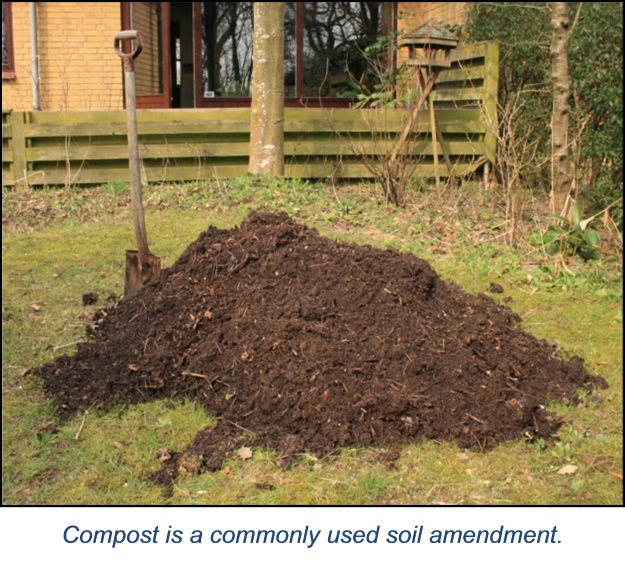Soil Amendments

Description
Soil amendments, which include both soil conditioners and fertilizers, make soil more suitable for plant growth and increase soil water retention. Soil amendments are also used to enhance native or disturbed and compacted soils.
A variety of techniques are included as potential soil amendments including aerating; fertilizing; and adding compost, other organic matter, or lime to the soil. These measures change the physical, chemical, and biological characteristics of the soil, allowing it to more effectively reduce runoff volume and filter pollutants. Soil amendments are valuable in areas with poor soils because they can help add available plant nutrients and sustain vegetative cover, reduce long-term erosion, and help reduce runoff peak volumes and discharges by absorption of rainfall and runoff.
Water Quality Benefits
Soil amendments increase the spacing between soil particles so that the soil can absorb and hold more moisture. Studies have indicated an increase in total soil storage capacity of 65% in compost amended soils.
Amended soils have the ability to remove pollutants through sorption, precipitation, filtering, and bacterial and chemical degradation. The decrease in runoff volume improves water quality by reducing pollutant mass transport. In addition, compost materials used for amendments are less prone to erosion than topsoil or compacted subsoil.
Design Considerations
Soil amendments can improve the water retention capacity and properties of almost any soil, but have the greatest impact in areas with poorly draining native soils. Soil amendments may be used during the construction and/or maintenance of BMPs to increase soil permeability and BMP effectiveness. For example, water quality swales can be treated with soil amendments. Soil amendments can also be used to increase the permeability of grass filter strips surrounding infiltration trenches to increase their effectiveness as pretreatment devices.
If the site does not contain adequate topsoil, the soils should be amended prior to establishment of vegetation. It is preferable to amend existing soils rather than import large quantities of topsoil. The use of soil amendments with organic matter that has a low bulk density reduces compaction. Materials such as compost, leaf mold, partially rotted manure, or composted sewage sludge are excellent, inexpensive sources that can often be found commercially. In addition to compost, soil conditioners, and fertilizers may be appropriate for use where the existing soil is badly damaged.
Before using soil amendments, the existing soil conditions should be evaluated. Consult a soils scientist to develop a soils amendment specification appropriate to your site based on the soil type to be amended and the type of vegetation to be established. Soil amendment media should be added at a rate of 2:1 (soil:compost). For minor compaction of soils, add 6 inches of amendment and till up to 8 inches and for major compaction, add 10 inches of amendment and till up to 20 inches. In areas where compaction is less severe, planting native vegetation alone can treat minor compaction.
Other points to keep in mind with respect to the use of soil amendments include the following:
- Don’t over improve soils; aim to approximate nutrient levels of the best soils in the local region.
- Build the soil by adding compost and other recycled materials or by planting restorative plants.
- Wherever soil amendments and erosion control materials are needed, specify recycled local materials, if possible.
- During construction, stockpile existing topsoil on site and reuse it for vegetated areas. Wherever possible, avoid bringing in fresh topsoil to a construction site by amending existing soils.
Maintenance
Routine inspection of amended soils should evaluate factors that may decrease the soil’s infiltration capacity, aeration and organic content. Typical post-construction concerns include areas subject to compaction, hydric or waterlogged soils, poor cover conditions, increased development, and a decrease in organic content. In addition, a routine soil infiltration rate analysis of amended soils in potential problem areas is recommended. Corrective actions for soil amendments involve restoring the infiltration capacity of the soil by aeration, deep tilling, and adding additional amendments. Reductions in infiltration capacity typically result from compaction or extensive root matting of groundcovers, such as grasses.
Performance and Inspection
To ensure proper performance, visually inspect amended soils for compaction, waterlogged soils, or diseased vegetation. All may be signs of soil function loss or failure. The first corrective action should be extensive mechanical aeration. If this does not restore the infiltration rate, organic amendments should be disked into the soil to a depth of several inches. Diseased vegetation should be removed and replaced. Soil samples may be taken prior to any remedial actions to determine the condition of the soils. Annual visual inspections should be conducted to identify any problem areas.